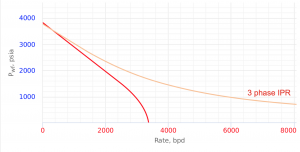Difference between revisions of "3 Phase IPR"
From wiki.pengtools.com
(→Three-phase Inflow Performance Relationship) |
(→See also) |
||
| Line 76: | Line 76: | ||
==See also== | ==See also== | ||
| − | :[[ | + | :[[IPR]]<BR/> |
| + | :[[Vogel's IPR]]<BR/> | ||
:[[Darcy's law]]<BR/> | :[[Darcy's law]]<BR/> | ||
| − | |||
| − | |||
{{#seo: | {{#seo: | ||
Revision as of 09:00, 11 April 2019
Contents
Three-phase Inflow Performance Relationship

3 Phase IPR Curve [1]
3 Phase IPR calculates IPR curve for oil wells producing water at various watercuts.
3 Phase IPR equation was derived by Petrobras based on combination of Vogel's IPR equation for oil flow and constant productivity for water flow [1].
3 Phase IPR curve is determined geometrically from those equations considering the fractional flow of oil and water [1].
Math and Physics
Total flow rate equations:
For Pb < Pwf < Pr
For pressures between reservoir pressure and bubble point pressure:
For PwfG < Pwf < Pb
For pressures between the bubble point pressure and the flowing bottom-hole pressures:
where:
For 0 < Pwf < PwfG
where:
And
3 Phase IPR calculation example
- PQplot nodal analysis software is used to calculate the IPR curves. PQplot is available online at www.pengtools.com.
- Excel
- other
Nomenclature
 = calculation variables
= calculation variables = oil fraction, fraction
= oil fraction, fraction = water fraction, fraction
= water fraction, fraction = productivity index, stb/d/psia
= productivity index, stb/d/psia = pressure, psia
= pressure, psia = flowing rate, stb/d
= flowing rate, stb/d
Subscripts
- b = at bubble point
- max = maximum
- o = oil
- r = reservoir
- t = total
- wf = well flowing bottomhole pressure
- wfG = well flowing bottomhole pressure at point G













